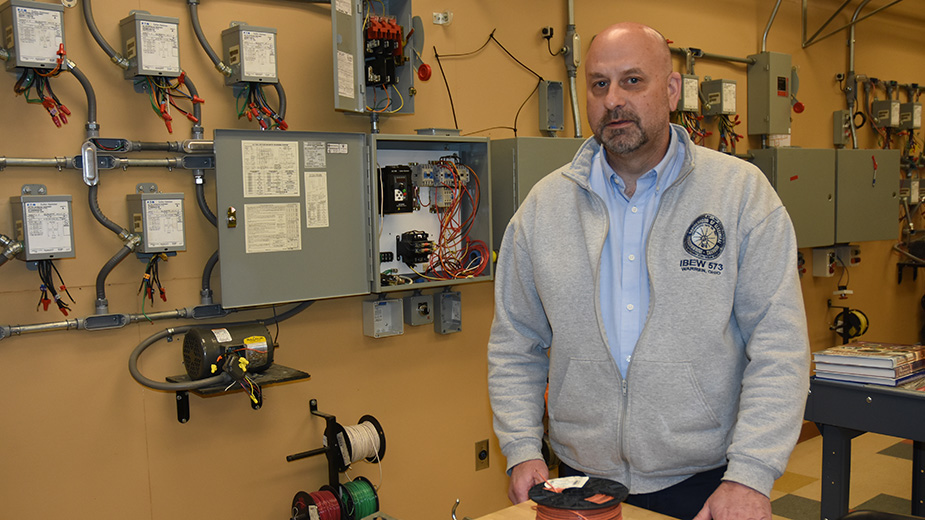So Many Jobs, So Few Electricians
YOUNGSTOWN, Ohio – Mike Nemkovich, business manager of the International Brotherhood of Electrical Workers Local 573 in Warren, looks at the dozens of work slips spread across his office desk on a Friday afternoon, all of them requesting union electricians to staff a variety of jobs in the region – by Monday.
“I don’t have all the people lined up yet,” Nemkovich says. “We probably won’t get all of them. It’s been nonstop here.”
Local 573 boasts more than 300 members today, compared with approximately 250 members several years ago, Nemkovich says. “We’ve been swamped. Our biggest issue is manpower right now.”
A similar issue affects IBEW Local 64 in Boardman, where business manager Scott Satterlee says its entire 387-strong membership is on the job. “Everybody is working and I could use more guys,” he says.
Local 573 serves Trumbull County and parts of Mahoning, Ashtabula, Portage and Geauga counties, while Local 64 serves Mahoning County and portions of Columbiana and Trumbull counties.
Between the two union jurisdictions, billions of dollars in new development or construction projects are either underway, recently completed, or are in the planning stages.
Moreover, from the vantage point of these business managers, the work isn’t slowing down any time soon.
Much of the present demand is driven by Ultium Cell’s $2.3 billion electric-vehicle battery cell production factory under construction in Lordstown – the backyard of Local 573.
Since the first quarter of 2020, contractors representing all of the trades have been on-site, building the 2.8 million-square-foot Ultium plant, Nemkovich says. The IBEW has figured prominently in the project.
With demand for electrical workers at a premium, Nemkovich says Local 573 had to draw from other regions to staff a job of this magnitude.
“There are a lot from Mahoning County, Akron, Canton, Painesville, Cleveland,” he says. Other IBEW locals were called in from western Pennsylvania and as far away as Texas and Louisiana, he says.
In all, Nemkovich says, there are some 400 IBEW electricians from other locals staffing jobs in his jurisdiction, in addition to the more than 300 from Local 573.
And more opportunities are on the horizon, he says, citing ongoing work at Lordstown Motors Corp. and the potential for Foxconn assuming ownership of that plant. “They’re going to need a ton of people in there,” he says.
Future work could also entail a second power-generation plant slated for Lordstown and the possibility of a new Mercy Health hospital in Champion near Kent State University Trumbull Campus, Nemkovich says.
At the same time, union contractors who shy away from the larger projects now have more opportunities on some smaller jobs, Nemkovich says. “Some contractors like the smaller jobs and are probably getting overloaded, too,” he says.
The challenge going forward is to continue adding to the ranks of the membership, Nemkovich says. “We need to grow to maintain our market share,” he says. “If we can’t get manpower to contractors, then we could lose out to nonunion workers.”
This is why programs such as Joint Apprenticeship Training Committees, or JATCs, are important to attract new talent to the electrical trades, Nemkovich says.
The JATC is a partnership between the IBEW and the National Electrical Contractors Association, or NECA. Under the JATC, both contractors and labor officials set new curriculum and administer apprenticeship programs that provide on-the-job training to those seeking careers in electrical work.
Nemkovich says interest in the electrical trades is on the rise, based on the number of apprentices added to the rolls last year compared to previous classes. “Normally, we would take between eight and 10 in the past,” he says. “Last year, we took 28 because the need was there.”
This year, Local 573 will probably accept about 15 into the program, he says. “The need’s going to be there again, and it doesn’t look like it’s going to stop anytime soon.”

The overall national job outlook for electrical workers is also bright over this decade, data show. Employment in the electrical trades is expected to grow 9% between 2020 and 2030. Projections show the addition of 66,100 positions, according to the U.S. Department of Labor Bureau of Labor Statistics.
An average of approximately 84,700 job openings for electricians are projected each year over the decade, according to BLS. Many of these openings result from the need to replace workers who have retired or transferred to other occupations, the agency reports.
“I would say the level of interest in apprenticeships has always been high,” says Local 64’s Satterlee.
Recently, these programs have gained traction because area high schools and organizations have helped to boost awareness of strong, enduring careers in the trades.
“More nonunion electricians have become interested, attracted by better wages and benefits,” he says.
Local 64’s first-year class for 2021-2022 saw the addition of 15 apprentices, nine in the commercial field and six for residential work, Satterlee says. “We’ll be taking another class in September as well.”
Apprentices who join the program start at about $13 per hour and receive pay raises every six months, Satterlee says. After successfully completing five years in the program, the apprentice is eligible for journeyman credentials. A journeyman’s pay tops out at $36 per hour.
A good portion of the classroom work is done at IBEW 64’s JATC training center in Boardman, Satterlee says. There, students learn electrical theory and practice through both textbook and practical, hands-on training. Apprentices work with programmable logical controls, or PLCs, mock-ups of commercial and residential wall panels to thread conduit, and other practicum.
“It seems like yesterday that I was an apprentice,” Bud Leonard says reflectively. Leonard has been an electrician for 17 years. “I was 23 when I came in and we didn’t have any of this,” he says, gesturing to the floor of NECA-IBEW training center, constructed about six years ago.
Added to IBEW curricula this year is a pathway to certification for the installation and maintenance of electrical-vehicle charging stations, Satterlee says. The coursework has become part of the standard apprenticeship program and is also open to experienced electricians who have their journeyman’s card.
“I think this is the future; it’s definitely coming down the pike,” says Mark Gentile, owner of MG Electric LLC in Poland. Gentile and his crew are taking courses through Local 64 toward certification in this field, which could be advantageous in the future as the EV charging infrastructure builds out.
The company installed the three charging stations at the WRTA bus garage and administration building in Youngstown, Gentile says. “It took a couple of weeks,” he says, noting that WRTA’s stations are designated as Level 2 chargers, which provide a much slower charge than the EV fast chargers.
Gentile says that he wants to be prepared as the adoption rate for EVs climbs and the number of charging installations – especially fast chargers – also increase in this region.
MG Electric has also installed several residential chargers for Tesla owners and those of other EV models, Gentile says.
“We’re looking for opportunities anytime to get involved in the EV market,” he says. “EVs are going to be the wave of the future.”
Satterlee says the initiative – known as the electrical vehicle infrastructure training program, or EVIT – comes at a perfect time as the EV market slowly begins to ramp up. “It’s a big thing that the IBEW is in front of right now,” he says. “We want to be sure we have the most qualified and best trained electricians. I think this is just the quiet before the storm.”
In the meantime, there is plenty of work underway to keep Local 64’s membership busy, Satterlee says. “It’s been one of our busiest years for residential,” he says. “There are a ton of new houses going up.”
Major projects underway include expansions at Youngstown Orthopedic Center and Akron Children’s Hospital in Boardman, upgrades at Seminary High School in Poland, a new storage center for the Salem Public Library, renovations of downtown Youngstown landmarks such as the Gallagher Building and a former steel warehouse being converted into Penguin City’s new brewery.
“Our work has stayed steady,” Satterlee says. “We have a lot of commercial work but we’re busier than usual.”
Pictured: Mike Nemkovich says IBEW Local 573 in Warren says it’s tough to fill all the project requests for union electricians.
Copyright 2024 The Business Journal, Youngstown, Ohio.



